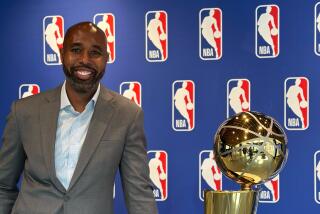It’s an Admirable Policy, but Hardly an Innovative One
- Share via
Sam Wyche, coach of the Cincinnati Bengals, has this crazy idea. When his Bengals report to training camp this week, black players will be assigned to room with white players, and vice versa, in the team dorms.
Wyche hopes to promote team unity.
This is an idea whose time has come.
In fact, it’s an idea whose time came almost 30 years ago, right here in Los Angeles. More about that in a minute.
I have a hunch that the story about Wyche and the Bengals surprised a lot of people. The surprise would be that such a plan would be necessary, that on professional sports teams in 1988 there exists any racial clumping. Aren’t these teams families?
But the clumping does exist. Tommy Hawkins, the Dodgers’ vice president of communications, tells me this phenomenon even has an official psychological name--”consciousness of kind.”
“In other words,” Hawk says, “birds of a feather. Each of us is most comfortable gravitating to those who look like us, communicate like us and have common experiences.”
This phenomenon is stronger in football because of the positions. For instance, most wide receivers and cornerbacks are black, so they tend to flock together socially. And quarterbacks and kickers, predominantly white, tend to hang with their own kind.
This birds-of-a-feather thing also exists to an extent in other sports. This is not to say that there is widespread racial tension. Racial harmony is the rule in sports, not the exception. But if you run into a ballplayer in a hotel lobby, and he’s on his way to meet a teammate for dinner or a movie, chances are fairly good he’s meeting a player of the same race.
“That’s OK,” Hawkins points out, “but when it (consciousness of kind) is used to the exclusion of getting to know what other people are about, it takes away from your effective communication and team play.”
That’s what Wyche is thinking about. And that’s sort of what Fred Schaus was thinking about in 1960. The Laker franchise had just shifted from Minneapolis to Los Angeles, and Fred had just shifted from coaching West Virginia University to coaching the Lakers.
Schaus assigned each Laker a new roommate on each trip, without regard to race, creed or height. There were three black players on the team--Hawkins, Elgin Baylor and Ray Felix.
“I don’t think what Fred did was racially motivated,” says Hot Rod Hundley, a starting guard on that team. “He just didn’t want players forming cliques.”
Still, it was a pretty progressive idea for 1960. The idea of blacks in pro basketball was in the experimental stage. Team owners feared that too many black players would drive off the white fans. Allegedly, there were unwritten quotas--you didn’t start three blacks.
If there was a quota, Schaus couldn’t change it, but he could promote team unity, and he did.
“It (the rooming system) worked like crazy,” Hawkins said. “We had a hell of a close-knit group. If we did have any differences, racial or otherwise, we felt free to discuss them. Our situation, for that time, was unique. We were way ahead of other teams.
“Of course, some differences weren’t black and white. Jim Krebs (white) had to have the hotel window wide open, even in the dead of winter. Ray Felix (black) had to have the heat on high, and the covers piled on. So those two had their problems.”
A few years later, that stuff didn’t matter in the National Basketball Assn. By the mid-’60s, following the lead of Wilt Chamberlain, most players were rooming alone.
In football, players still have roommates on trips and in training camp, and the rooming preferences are generally along racial lines. So Wyche should be saluted for his attempt to unclump the colors.
Hawkins once taught a mass media class at Cal State Long Beach. The first day of class, he noticed that blacks, whites, Hispanics and Asians sat exclusively with their own kind. Hawkins looked around the room and said aloud, “Whoa! We can’t have this.”
Hawk shuffled the deck.
Nobody died, nobody even got sick.
Breaking up the old way of life on a football team, of course, is a more complex matter. This is how football works: When you’re a rookie, the team assigns you a roommate. Mainly because of that position thing I mentioned before, but also from age-old habit, like colors are usually paired off.
Veterans get to choose their own roomies, but they tend to keep their original ones. Generally, there’s not a lot of racial mixing. The only way there ever will be is if someone makes a conscious effort, someone such as Wyche, who is casting about for ways to improve on last season’s 4-11 record.
Maybe it’s a sad commentary that 28 years after the Lakers did this simple roomie rotation, it’s still news. But even slow progress is progress.
“We don’t have a (racial) problem,” Wyche stressed to me Monday. “But we still see tables in our dining room that are predominantly white or predominantly black. They (blacks and whites) probably don’t know each other as well as they might. There’s a line of division that’s real, let’s be honest.
“The end product (of the new plan), we hope, is that everyone on the team is going to know the other guy a little better, come crunch time. Somewhere along the line, it’ll make us tougher to whip.
“I’m just trying to scramble the eggs a little bit.”
Of course, Sam is going too far. He’s mixing not only races, but also platoons. He will room offensive players with defensive players, and everybody knows God never intended there to be such a co-mingling.
Offense and defense should have separate dorms and separate drinking fountains.
More to Read
Go beyond the scoreboard
Get the latest on L.A.'s teams in the daily Sports Report newsletter.
You may occasionally receive promotional content from the Los Angeles Times.










